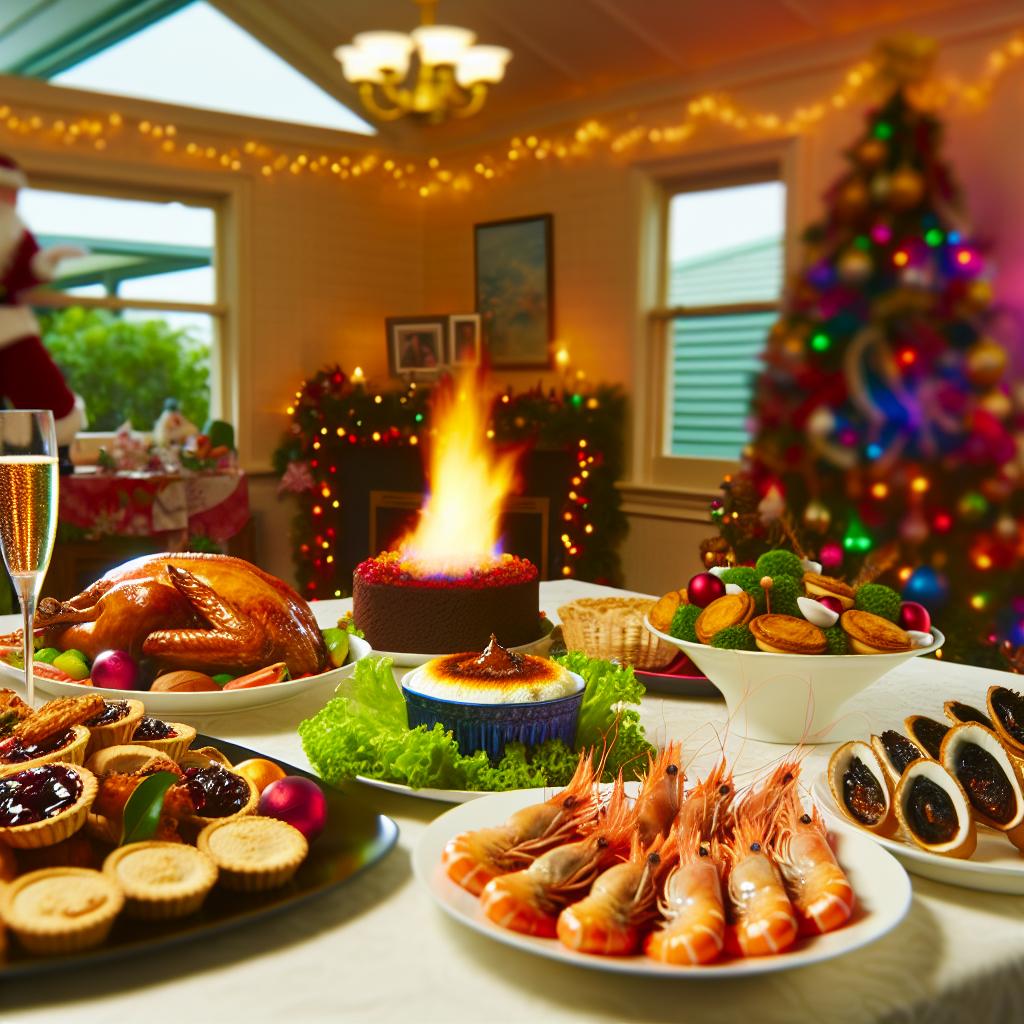
Traditional Australian Christmas foods.
Introduction to Traditional Australian Christmas Foods
In Australia, the festive season falls in the middle of summer, which strongly influences the traditional Christmas fare in many households. The country’s warm climate means that Australians typically bypass the more heavy, wintery dishes seen in the Northern Hemisphere, instead opting for foods that reflect both the warmth of the season and the multicultural tapestry of the society. This document provides an in-depth look at the foods that are central to Australian Christmas celebrations, showcasing a unique blend of tradition and adaptation to local conditions.
Prawn and Seafood Platters
Seafood holds a place of prominence in the Australian Christmas culinary landscape. Given Australia’s expansive coastline, it’s no surprise that prawn and seafood platters are mainstays at many tables during the festive season. Prawns, which are incredibly versatile, can be served both warm or cold. They are often presented elegantly on large platters, surrounded by accompaniments like lemons, cocktail sauce, or aioli. Oysters, served fresh with a squeeze of lemon or a spicy vinaigrette, offer a gourmet touch, while crab, whether cracked open straight from its shell or incorporated into salads, adds to the indulgence. These seafood delights not only cater to the Australian palate but also underscore the appeal of fresh, local produce.
Barbecues
The quintessential Australian Christmas celebration would be incomplete without the presence of a barbecue. With the sun shining bright and the outdoors beckoning, many Australians choose to celebrate Christmas by hosting a barbecue feast. This method of cooking encourages a communal atmosphere, where family and friends can come together to enjoy each other’s company. On these occasions, various meats such as lamb, beef, and an array of seafood are grilled, capturing the signature smoky aroma that comes with barbecuing. Salads, corn on the cob, and cold beverages typically accompany these grilled delights, creating a balanced and vibrant meal that is as pleasing to the eyes as it is to the taste buds.
Christmas Ham
Despite the summer season, a glazed Christmas ham remains an enduring favorite among Australian households. Traditionally, this dish hearkens back to colonial influences, yet it has been readily embraced and adapted to fit the modern Australian holiday repertoire. A typical Christmas ham is glazed with ingredients such as honey, cloves, and mustard, which impart both a glossy appearance and a rich flavor profile. Although it’s often served hot in many parts of the world, Australians frequently enjoy their ham cold, making it refreshingly suitable for the summer climate. The ham is not just a centerpiece on its own but also provides versatile leftovers, perfect for sandwiches or as part of a Boxing Day brunch.
Pavlova
Desserts play an integral role in the festive dining experience, and in Australia, pavlova stands as a symbolic centerpiece of Christmas dessert offerings. Pavlova is a meringue-based dessert that is both crispy on the outside and marshmallow-light on the inside. When topped with an array of fresh fruits such as kiwi, strawberries, and passionfruit, this dessert encapsulates the vibrant and refreshing qualities ideal for a summer celebration. Its origins are disputed between Australia and New Zealand, but regardless of its roots, pavlova has become an entrenched part of Australian Christmas festivities. The dessert is as much about its beautiful presentation as it is about its taste, often forming a crowning glory on many Christmas tables.
Fruit Mince Pies
Taking inspiration from British culinary traditions, fruit mince pies are a cherished aspect of an Australian Christmas. These small pastry pies are filled with “mincemeat,” a rich mixture of dried fruits, suet, spices, and aged brandy or rum. Although the word ‘mince’ might suggest otherwise, these pies have not contained actual meat for several centuries. The baking of these pies marks a warm, aromatic presence, often infused with the heady scent of cinnamon, cloves, and nutmeg. They are typically enjoyed with a bracing cup of tea or perhaps a glass of chilled dessert wine, embodying both the season’s spirit and the story of culinary migration that brought them to Australian shores.
Conclusion
Australian Christmas foods offer an enticing fusion of tradition and innovation, shaped by the country’s geographical and cultural landscapes. The dishes, from seafood platters brimming with local produce to classic pavlova, articulate a story of joyous adaptation while maintaining links to historical culinary influences. In celebrating Christmas, Australians have found a way to honor both their unique conditions and the diverse cultural inputs that define their national identity. Whether it’s gathered around a barbecue in the sun or selecting a second helping of pavlova, the spirit of warmth and festivity shines through the traditional Australian Christmas meal. For those curious about the full breadth of both traditional and modern Australian cuisine, further exploration into various resources is encouraged. As such, discovering the complete culinary tapestry that Australia offers might begin with resources like SBS Food.





